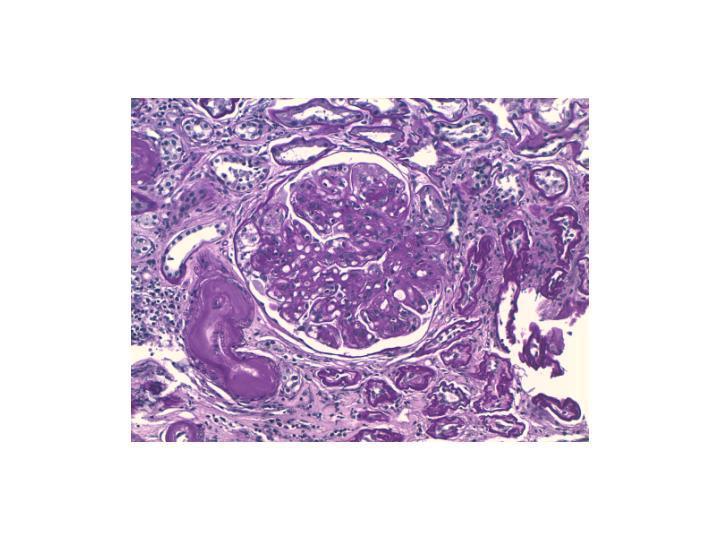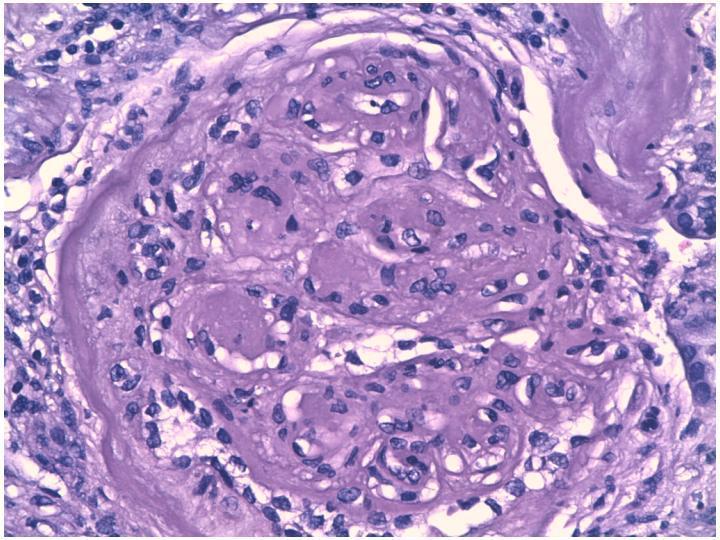To the Editor,
Diabetic nephropathy (DN) is the leading cause of chronic kidney disease (CKD) in developed countries,1 with an increasing incidence and prevalence. We describe the effects of diabetes mellitus (DM) on the kidney after years of natural development (without prior renoprotective treatment and poor metabolic control).
Case report
A 60-year old man with a previous history of type 2 DM for more than 20 years, treated with antidiabetic agents initially and insulin for the last 5 years, and with poor metabolic control. Non-proliferative diabetic retinopathy. Ex-smoker of 30 cigarettes per day until 5 years ago.
The patient visited the emergency department complaining of generalised oedema of one month duration, dyspnoea, and 2-3 times nocturia. On physical examination, the patient was in good general condition, was conscious and oriented. Blood pressure was 160/110mm Hg, heart rate 80 beats/min. Jugular venous distension. Cardiac auscultation was rhythmic. Pulmonary auscultation showed minimum crackles in the bases. Pitting oedema to knee. The rest of the examination was normal.
Blood analysis revealed glucose 200mg/dl, urea 52mg/dl, creatinine 1.2mg/dl, uric acid 5.3mg/dl, cholesterol 313mg/dl, triglycerides 144mg/dl, albumin 1.9g/dl, total protein 4.4g/dl, calcium 7.6mg/dl, phosphorus 3.2mg/dl, iron 41 μg/dl, and ferritin 155ng/ml. The haemoglobin was 11.6g/dl, haematocrit 34.3%, and the rest of the blood count and coagulation tests were normal. The thyroid hormones, antibodies, viruses (HIV, hepatitis B and C) and PSA were normal. Haemoglobin A1c was 8.3%. The immunological test, including immunoglobulin, complement, rheumatoid factor, ASO, ANA, anti-DNA, ANCA and C-reactive protein were also normal.
The urinalysis revealed protein +++, blood + glucose ++ and negative nitrite. Proteinuria in 24-hour urine collection was 10g. In urine electrophoresis, proteinuria was non-selective, with the Bence-Jones proteinuria negative.
The chest x-ray revealed cardiomegaly and signs of venocapillary stage II hypertension. The abdominal ultrasound found the right kidney to be 12cm, of normal morphology, and the left kidney was 15cm, with dilatation of the excretory system.
Depletive treatment was initiated with diuretics, angiotensin-converting enzyme (ACE) inhibitors and angiotensin II receptor blockers (ARBs), statins, low molecular weight heparin, and improvement of glycaemic control was recommended. Given the left kidney hydronephrosis caused by ureteropelvic junction syndrome, pyeloplasty was performed and a percutaneous nephrostomy tube was placed in the left kidney. Despite these measures, the patient required further hospital admissions for acute nephrotic syndrome, with plasma creatinine increasing to 2.5-3mg/dl and persistent nephrotic proteinuria, which is why it was decided to initiate haemodialysis. Although DN was initially suspected, as poor volume control persisted during haemodialysis, with biochemical activity of the nephrotic syndrome, we decided on a renal biopsy to rule out associated glomerulopathy. The biopsy findings were: 12 glomeruli per section, five of them completely sclerosed. All the glomeruli studied showed mesangial expansion with acellular nodules (Kinmelstein-Wilson). Immunofluorescence was negative. In the interstitium, there was moderate fibrosis with associated focal tubular atrophy. The vascular tissue showed a striking hyalinosis of the wall, being the final pathological diagnosis consistent with a diffuse (Figure 1) and nodular (Fig. 2) glomerulosclerosis, with a morphological substrate of diabetic disease.
Discussion
Metabolic and haemodynamic factors have been implicated in the pathogenesis of DN,2 Angiotensin II plays a main role in the pathogenesis and progression of DN, and its inhibition confers renoprotection in patients with diabetes.3 A delay in starting treatment with ACE inhibitors or ARBs in patients with type 2 diabetes, proteinuria and renal failure, makes them less effective, hence the importance of early treatment.3 In the case presented, despite starting therapy during the first admission with renin-angiotensin-aldosterone system (RAAS) inhibitors, the nephrotic syndrome remained uncontrolled and the patient had to be readmitted for hydropic decompensation. This lack of response to treatment may be explained, firstly, by it being a DN of many years development with poor metabolic control; secondly, by the presence of severe proteinuria when the patient was first examined and the absence of prior therapy with antiproteinuric drugs; and thirdly, by the histological findings of the renal biopsy.
With current treatment, the progression of DN to CKD remains, so the RAAS inhibition may not be enough. Recently, new therapeutic agents have been described that may have a role in slowing the progression of DN.4 Hormone receptors that play a protective role in cardiovascular, inflammatory and metabolic diseases have been seen. Thus, its modulation may provide new “targets” for treatment. In the case of DM, the most studied receptors are oestrogen, PPAR-gamma and vitamin D.5
Chronic hyperglycaemia promotes the generation of advanced glycation end products, AGEs.2 Thus, AGE inhibitors (aminoguanidine, ALT-946, pyridoxamine, thiamine) and AGE receptor (RAGE) antagonists4 have been described.
Another potential agent (due to its rheological and anti-inflammatory properties) is pentoxifylline,6 which has been shown to have renoprotective and antiproteinuric effects in animal studies.7 In addition, a recent meta-analysis of randomised controlled trials reported that pentoxifylline has an antiproteinuric effect in patients with diabetic kidney disease.8
There is also evidence that activation of protein kinase C (PKC) causes renal failure (hyperfiltration, basement membrane damage and glomerulosclerosis). Among the PKC inhibitors, ruboxistaurin has demonstrated a promising effect in the prevention of diabetic vascular complications.4
Lastly, several growth factors are expressed in the normal kidney and have been implicated in the pathogenesis of DN, and TGF-beta, CTGF and VEGF inhibitors are potential therapeutic agents.9
In short, in the RAAS inhibition era, it is still possible to detect patients with a natural course of DN. The delay in the start of treatment makes the subsequent response discrete. In the coming years, new therapeutic agents will be checked for their utility in preventing the onset of DN and/or delaying the progression to CKD.
Figure 1. . PAS technique (x20): diffuse glomerulosclerosis with hyalinosis of the efferent arteriole and intense hyalinosis of the medium-calibre vessels
Figure 2. Haematoxylin-eosin technique (x40): typical nodular glomerulosclerosis










